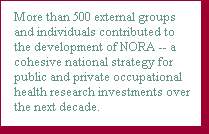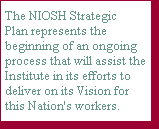Strategic Plan 1997-2002
1998
DHHS (NIOSH) Publication Number 98-137
Report
- Strategic Plan 1997-2002
- NIOSH Strategic Goal 1 — 3
- NIOSH Strategic Goal 4
NIOSH Strategic Goal 4
Provide workers, employers, the public, and the occupational safety and health community with information, training, and capacity to prevent occupational diseases and injuries.
In conjunction with recommending actions for preventing occupational disease and injuries, NIOSH believes that the Nation's health can be improved by translating its basic and field research into forms of information that the entire occupational safety and health community can understand and act upon.
Many varied audiences rely on the results of NIOSH activities. The list of individuals and organizations to which NIOSH must communicate occupational safety and health information includes researchers, employers, employees, OSHA, MSHA, policy makers, manufacturers, trade associations, unions, other government agencies, students and the media. A key NIOSH goal is to communicate scientific findings to diverse stakeholders and the public. Today, NIOSH publishes and distributes a wide array of documents to meet the needs of these varied audiences. Examples include Health Hazard Evaluation Reports, Alerts, Current Intelligence Bulletins, criteria documents, fact sheets, and reports.
In recent years, NIOSH has focused its obligation to disseminate safety and health information through its Office for Health Communication in Washington, D.C., its Division of Education and Information in Cincinnati, Ohio, and its new Health Communications Research Branch in Morgantown, West Virginia. Together these units have moved health communications into the 21st century through the use of mass media, publicly accessible data bases, and the Internet.
In addition, NIOSH understands that the future of occupational safety and health prevention efforts rests greatly on the development and training of safety and health professionals as well as the integration of occupational medicine into mainstream medical training. To this end, NIOSH currently funds 15  universities to conduct degree programs through Education and Research Centers and 35 universities with single programs (training project grants) throughout the United States. These centers train physicians, nurses, industrial hygienists, safety professionals, engineers, and other safety and health professionals. In addition, NIOSH supports the International Training and Research in Environmental and Occupational Health Program (ITREOH), which links 13 U.S. institutions with occupational safety and health professionals in 23 countries. As we move into the next century — where the needs of the workforce and workplace will be continuously changing — NIOSH must evaluate and update its training programs.
universities to conduct degree programs through Education and Research Centers and 35 universities with single programs (training project grants) throughout the United States. These centers train physicians, nurses, industrial hygienists, safety professionals, engineers, and other safety and health professionals. In addition, NIOSH supports the International Training and Research in Environmental and Occupational Health Program (ITREOH), which links 13 U.S. institutions with occupational safety and health professionals in 23 countries. As we move into the next century — where the needs of the workforce and workplace will be continuously changing — NIOSH must evaluate and update its training programs.
Objectives
Strategic Goal 4
Objectives - FY 1999
- Review the most widely distributed existing documents and new documents and training materials to ensure that they are designed and written for the intended user.
- Conduct a review and a user survey of NIOSH public documents that affect the greatest number of workers or employers. This review and user survey should include recommendations made after interventions. Objectives should be to evaluate quality, usefulness, content relevancy, and distribution.
- Review existing communications efforts to ensure that they focus on high-risk sectors and NORA priority areas.
- Design and implement two model information dissemination and training programs for key target hazards (silicosis ) or populations (e.g., adolescents).
- Make the data obtained through NIOSH field research accessible to a broad population through the use of the Internet and other devices.
- Expand the training of occupational safety and health professionals through the in-house use of internships and fellowships to graduate students and others.
- Make NIOSH materials available on the NIOSH homepage on the Internet.
- Develop interactive expert systems for NIOSH information on the Internet.
- Increase employer and employee knowledge and use of the NIOSH toll-free information number.
- Provide technical assistance to the mining industry though technology and training materials.
Objectives - FY 2002
- Develop assessment strategies that will identify the demand and need for occupational safety and health professionals, future trends, and gaps in NIOSH training programs.
- Develop assessment strategies that will identify the demand and need for occupational safety and health information, future directions in delivering information, and potential information gaps in NIOSH dissemination programs.
NIOSH Strategic Tools
Scientific Research
Without a doubt, the core of NIOSH activity is research — in the laboratory and in the field. Research allows the Institute to (1) understand the causes and mechanisms of diseases and disorders (2) investigate exposures, illnesses, fatalities, and injuries, and (3) develop and evaluate control technologies at the worksite. NIOSH is committed to continuing and expanding intramural and extramural research activities in NORA priority areas and other critical areas. This commitment is demonstrated by our ongoing efforts to bring the new Morgantown research facility on line. Only through continued support of occupational safety and health research can we continue to move toward a safe and healthy future for this Nation's workers.
NORA — A Process of Consultation With Partners
NIOSH is in a position to demonstrate what the Federal government can achieve when it works closely with public and private partners and stakeholders. More than 500 external groups and individuals contributed to the development of NORA — a cohesive national strategy for public and private occupational health research investments over the next decade. Moreover, additional partners have become involved in NORA implementation under NIOSH leadership. Over the coming years, NIOSH plans to bring the lessons learned in this process to other areas of NIOSH activity such as prevention  and training. NIOSH will also seek out opportunities to form partnerships with other components of the occupational safety and health community and thereby expand the impact of its work.
and training. NIOSH will also seek out opportunities to form partnerships with other components of the occupational safety and health community and thereby expand the impact of its work.
Partners are also important on the international front. One of the strengths of NIOSH in recent years has been its coordination and collaboration with other countries having similar occupational safety and health problems and international organizations. We pledge to continue these efforts.
Flexibility to Adapt to the Changing Nature of the Workplace
As this Nation moves into the next century, the issues at the workplace will change. NIOSH is committed to changing as well. The Institute will maintain the flexibility to meet the research needs associated with (1) new and emerging technologies as they are brought to the workplace of the future, and (2) the workplace changes brought about by changes in the organization of work and the increasing globalization of the economy. We are also committed to adapting as the workforce becomes older and more diverse and includes workers at a younger age. The needs of these workers will require innovative approaches and solutions.
Impact Factors
NIOSH Reliance on Partners
Congress purposely placed NIOSH (which is primarily a research institute) in a position where it must rely on others in the occupational safety and health community to have a direct impact on the overall level of hazards in the workplace. NIOSH has developed a number of systems and programs to bring it into partnership with all segments of the occupational safety and health community. But it is the designated role of NIOSH and its required reliance on the actions of others that have and will continue to have an important impact (both positive and negative) on its ability to deliver fully on its vision of a safe and healthful workplace for all.
Government Decisions
The NIOSH strategic plan is contingent on the support of all aspects of the U.S. government. That is, for NIOSH to meet  the goals of this plan, it requires growing resources, the support of Congress and the Administration for the NIOSH mission and the research it envisions, and judicial rulings that support the continuing role of science in protecting the health of this Nation. Changes in any of these areas will have a negative impact on the work of NIOSH and on the ability of NIOSH to meet the expectations of GPRA and this plan. If government support should decrease in the coming years, NIOSH will adjust its expectations accordingly.
the goals of this plan, it requires growing resources, the support of Congress and the Administration for the NIOSH mission and the research it envisions, and judicial rulings that support the continuing role of science in protecting the health of this Nation. Changes in any of these areas will have a negative impact on the work of NIOSH and on the ability of NIOSH to meet the expectations of GPRA and this plan. If government support should decrease in the coming years, NIOSH will adjust its expectations accordingly.
With regard to financial resources, it must be noted that the FY'97 budget for NIOSH was 25% below its budget for FY'80 when adjusted for inflation using the biomedical research and development index. Simply stated, without an influx of resources to restore its research capacity NIOSH will be unable to meet the goals it has set for itself and for the safety and health of this Nation's workforce. Failure to provide sufficient resources will require NIOSH to scale back or eliminate important goals — an outcome that will be negatively affect NIOSH and the level of workplace safety and health for all of our Nation's workers.
The NIOSH Strategic Planning Process
The NIOSH Strategic Plan was developed by working with NIOSH employees throughout the Institute. Meetings were held in conjunction with the local partnership councils at various NIOSH locations throughout the Nation. Employees were encouraged to consider an early draft and answer questions including:
- Are the four strategic objectives the right ones for NIOSH?
- Does the plan portray NIOSH correctly?
- Does the plan include a broad enough cross-section of ongoing or planned NIOSH work?
- Does the plan relate to the work of my Division?
- Are there ways to tie the two together?
- Does the plan include measurements that will allow us to judge our progress?
Input from those meetings was included in this plan. 
Following that effort, a draft plan was distributed to partners and stakeholders to obtain their input. Many of their thoughts and suggestions have likewise been incorporated into this plan, and we are thankful for their input.
NIOSH believes that this plan represents the beginning of an ongoing process that will assist the Institute in its efforts to deliver on its Vision for this Nation's workers.
Healthy People 2000
Healthy People 2000 is a Health and Human Services prevention initiative that provides a national strategy for significantly improving the health of the American people over the decade of the 1990's. Healthy People calls on the Nation to make the following changes by the year 2000.
- Increase to 40 percent the proportion of worksites employing 50 or more people that provide programs to reduce employee stress.
- Reduce deaths from work-related injuries to no more than 4 per 100,000 full-time workers, with sub-goals for mining, construction, transportation, and farm workers.
- Reduce work-related injuries resulting in medical treatment, lost time from work, or restricted work activity to no more than 6 cases per 100 full-time workers, with subgoals for construction, nursing and personal care, transportation, mining, adolescent and farm workers.
- Reduce cumulative trauma disorders to an incidence of no more than 60 cases per 100,000 full-time workers with subgoals for manufacturing and meat product workers.
- Reduce occupational skin disorders or diseases to an incidence of no more than 55 per 100,000 full-time workers.
- Reduce hepatitis B infections among occupationally exposed workers to an incidence of no more than 623 cases.
- Increase to at least 95 percent the proportion of worksites with 50 or more employees that mandate employee use of occupational protection systems such as seatbelts during all work-related motor vehicle travel.
- Reduce to no more than 15 percent the proportion of workers exposed to average daily noise levels that exceed 85 decibles.
- Eliminate exposures that result in worker blood lead concentrations greater than 25 micrograms per deciliter (ug/dl) of whole blood.
- Increase hepatitis B immunization levels to 90 percent among occupationally exposed workers.
- Implement occupational safety and health plans in 50 States to identify, manage, and prevent leading work-related diseases and injuries within the State.
- Establish 50 State exposure standards adequate to prevent major occupational lung diseases to which their worker populations are exposed.
- Increase to at least 70 percent the proportion of worksites with 50 or more employees that have implemented programs on worker health and safety.
- Increase to at least 50 percent the proportion of worksites with 50 or more employees that offer back injury prevention and rehabilitation programs.
- Establish in 50 States either public health or labor department programs that provide consultation and assistance to small businesses to implement safety and health programs for their employees.
- Increase to at least 75 percent the proportion of primary care providers who routinely elicit occupational health exposures as a part of the patient history and provide relevant counseling.
- Reduce deaths from work-related homicides to no more than 0.5 per 100,000 full-time workers.
- Reduce the overall age-adjusted mortality rate for four major preventable occupational lung diseases (byssinosis, asbestosis, coal workers' pneumoconiosis, and silicosis) to 7.7 per 100,000.
- Increase to 100 percent the proportion of worksites with a formal smoking policy that prohibits or severely restricts smoking at the workplace.
- Enact in 50 States and the District of Columbia comprehensive laws on clean indoor air that prohibit smoking or limit it to separately ventilated areas in the workplace and enclosed public places.
- Reduce to zero the number of States that have clean indoor air laws preempting stronger clean air laws on the local level.
NIOSH Strategic Goals
An Outline of the Future
NIOSH Strategic Goal 1
Conduct a targeted program of research to reduce morbidity, injuries, and mortality among workers in high- priority areas and high-risk sectors.
Objectives - FY 1999
- Disseminate NORA throughout the occupational safety and health research community.
- Implement NORA through the formation of partnership teams for each NORA topic.
- Teams will consist of partners from all aspects of safety and health.
- Teams will assist in the development, pursuit, review, and dissemination of research.
- Evaluate the success of focusing occupational safety and health research on NORA priorities and other target areas by
- determining current levels of NIOSH and other Federal agencies' intramural and extramural research funding in NORA priority areas and calculating any annual increases, and
- developing a protocol for the use of bibliometrics and other research proxy measures (i.e., numbers of patents, engineering control devices, laboratory methods development, peer-reviewed articles, spin-off technologies, etc.) to evaluate the level of NORA and other targeted research in the occupational safety and health community.
- Report on the progress of NORA.
Objectives - FY 2002
- Evaluate the adequacy of existing procedures and tracking models to measure the impact of NORA and other NIOSH research on safety and health outcomes.
- Develop new procedures and capacities to measure the impact of NORA and other NIOSH research on safety and health outcomes.
- Update NORA (2002 mid-course review).
Ongoing Objective
- Increase knowledge and understanding of occupational safety and health issues through conducting and funding peer-reviewed research in NORA and other priority areas.
NIOSH Strategic Goal 2
Develop a system of surveillance for major occupational illnesses, injuries, exposures, and health hazards.
Objectives - FY 1999
- Undertake a comprehensive surveillance planning process with NIOSH partners at the State and Federal levels to establish surveillance priorities and define roles for various agencies.
Objectives - FY 2000 - FY 2002
- Implement the recommendations of the surveillance planning process for NIOSH in the areas of occupational injuries, illnesses, exposures, and health hazards.
- Develop procedures and capacities to measure the impact of the recommendations of the surveillance planning process on safety and health outcomes.
- Develop a demographics database that will represent miners in all States with mining operations.
Ongoing Objective
- Collect, analyze, and disseminate information on the distribution of occupational illnesses, injuries, exposures, and health hazards to target and evaluate intervention and prevention efforts.
NIOSH Strategic Goal 3
Increase occupational disease and injury prevention activities through workplace evaluations, interventions, and ecommendations.
Objectives - FY 1999
- Work with the occupational safety and health community to develop a system for assessing, determining the baseline level, and increasing the extent to which NIOSH recommendations are utilized by employers, workers, and government agencies at worksites, industry-wide, and in standard setting.
- Implement targeted evaluation of the effectiveness of prevention programs (e.g., latex allergy and agriculture-related injuries to children) by tracking the prevalence of an illness or injury, the level of exposure, and the behavior of affected workers and employers before and after the implementation of the program.
- Use new technology (e.g., virtual reality) in the design of prevention measures.
- Develop and implement criteria for selecting field investigation sites. These criteria should include the selection of workplaces with NORA or other priority areas or hazards. Determine the number of such investigations performed in FY'98 that met this criterion.
- Develop and communicate a plan for updating respirator certification regulations.
Objectives - FY 2002
- Increase the number of health hazard evaluations conducted at workplaces with NORA or other priority areas or hazards.
- Increase the number of work-site prevention activities implemented after a NIOSH report is issued.
- Increase the number of industry-wide control measures or devices put in place after the release of a NIOSH research report.
- Increase the number of NIOSH recommendations, including those in NORA priority areas and other targeted areas.
- Increase the number of NIOSH-sponsored or -conducted intervention effectiveness research projects in the occupational safety and health field, including projects in NORA or other priority areas.*
- Implement updated respirator certification regulations.
*Intervention effectiveness research is a NORA topic and will, therefore, be included under appropriate objectives of Goal 1 as well.
NIOSH Strategic Goal 4
Provide workers, employers, the public, and the occupational safety and health community with information, training, and capacity to prevent occupational diseases and injuries.
Objectives - FY 1999
- Review the most widely distributed existing documents and new documents and training materials to ensure that they are designed and written for the intended user.
- Conduct a review and a user survey of NIOSH public documents that affect the greatest number of workers or employers. This review and user survey should include recommendations made after interventions. Objectives should be to evaluate quality, usefulness, content relevancy, and distribution.
- Review existing communications efforts to ensure that they focus on high-risk sectors and NORA priority areas.
- Design and implement two model information dissemination and training programs for key target hazards (silicosis ) or populations (e.g., adolescents).
- Make the data obtained through NIOSH field research accessible to a broad population through the use of the Internet and other devices.
- Expand the training of occupational safety and health professionals through the in-house use of internships and fellowships to graduate students and others.
- Make NIOSH materials available on the NIOSH homepage on the Internet.
- Develop interactive expert systems for NIOSH information on the Internet.
- Increase employer and employee knowledge and use of the NIOSH toll-free information number.
- Provide technical assistance to the mining industry though technology and training materials.
Objectives - FY 2002
- Develop assessment strategies that will identify the demand and need for occupational safety and health professionals, future trends, and gaps in NIOSH training programs.
- Develop assessment strategies that will identify the demand and need for occupational safety and health information, future directions in delivering information, and potential information gaps in NIOSH dissemination programs.
- Page last reviewed: June 6, 2014
- Page last updated: June 6, 2014
- Content source:
- National Institute for Occupational Safety and Health Education and Information Division


 ShareCompartir
ShareCompartir